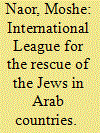| Srl | Item |
| 1 |
ID:
121873


|
|
|
|
|
| Publication |
2013.
|
| Summary/Abstract |
This article studies 1923 compulsory population exchange between Greece and Turkey through a case study of its experience in Izmir. It traces the ways the early Republican state engaged in the project of reshaping the population by eliminating the non-Muslims who were rendered as 'excesses' in the spatial and discursive matrices of the nation-state. Through the experience of the exchange in Izmir, it argues that the process of the accommodation and assimilation of the exchangees played a significant role in shaping the modalities of Turkish nationalism by creating new lines and fissures, further dividing the 'Muslim brethren' into ever restrictive constructions of Turkishness. It also underlines that this forced displacement is not just a significant episode in Greek and Turkish histories but that it represents a turning point in the project of nation formation in general.
|
|
|
|
|
|
|
|
|
|
|
|
|
|
|
|
| 2 |
ID:
171052


|
|
|
|
|
| Summary/Abstract |
This article discusses the campaign by the International League for the Rescue of the Jews in the Arab Countries (1948- 1950), formed by organisations representing Sephardi and Mizrahi Jews in Israel and the Herut party and aimed at preventing damage to the status of the Jews in the Arab states and promoting their emigration to Israel. The article will review the characteristics of the campaign, focusing on the public discourse it sparked in Israel around the idea of a population exchange between the Jews of the Arab states and the Palestinian refugees. This campaign, in which the memory of the Holocaust and the UN Convention on the Prevention and Punishment of the Crime of Genocide were employed, created a linkage between these two populations and expressed the political and social changes of this transitional period.
|
|
|
|
|
|
|
|
|
|
|
|
|
|
|
|
| 3 |
ID:
183749


|
|
|
|
|
| Summary/Abstract |
During 1950-1951 approximately 125,000 Jews immigrated to Israel from Iraq, where they had constituted 95% of the Jewish community. The vast number of migrants surprised the governments of Iraq, Israel, and Britain and the Iraqi Jews themselves because this had been an ancient, established, wealthy community, well integrated socially, economically, and culturally into Iraq, its perceived homeland. Moreover, the migrants’ destination, the impoverished young State of Israel, lacked appeal. One explanation for this phenomenon links it with a series of terrorist acts that occurred in Baghdad during 1951-1950, portraying them as an Israeli provocation that sparked panic and mass emigration. Although historical studies based on archival documents from the time refute this claim, it still has supporters among Arab countries, Jews of Iraqi background in Israel and elsewhere, and academics. This article juxtaposes the terrorism narrative with the findings of historical scholarship on the mass migration of Iraqi Jews, in an effort to explain the endurance and lasting influence of this narrative.
|
|
|
|
|
|
|
|
|
|
|
|
|
|
|
|